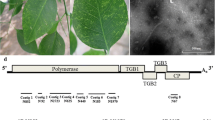Abstract
In September 2017, a yellow spot leaf disease was noted on the leaves of Prunus davidiana (Carr.) Franch. plants in Liaoning, China, and spherical virions (approx. 30 nm in diameter) were later observed in preparations of symptomatic leaves. Subsequent deep sequencing of small RNA revealed the presence of a virus in these symptomatic leaves The complete genome of this viral isolate consists of 6,072 nucleotides, excluding the poly(A) tail. The virus showed the closest genetic relationship to grapevine-associated tymo-like virus, reported in Colmar, France (GaTLV, MH383239), which is the sole member of the newly proposed genus “Gratylivirus” within the order Tymovirales, which is currently unassigned to a particular family. The virus clustered closely with GaTLV in a phylogenetic tree constructed based on complete genomic sequences. On the basis of the nucleotide and amino acid sequences of the replicase and coat protein genes, this virus shares the highest (although still relatively low) sequence similarity with those of GaTLV (41.6%–60.8% identity), indicating that the virus is a distinct member of the order Tymovirales, for which the name “prunus yellow spot-associated virus” (PYSaV) is proposed. To our knowledge, this is the first report of a virus naturally infecting P. davidiana.


Similar content being viewed by others
References
King AM, Adams MJ, Lefkowitz EJ (2012) Virus taxonomy: ninth report of the International Committee on Taxonomy of Viruses. Elsevier, Amsterdam
Hily JM, Candresse T, Garcia S, Vigne E, Tannière M, Komar V, Barnabé G, Alliaume A, Gilg S, Hommay G, Beuve M, Marais A, Lemaire O (2018) High-throughput sequencing and the viromic study of grapevine leaves: from the detection of Grapevine-infecting viruses to the description of a new environmental Tymovirales member. Front Microbiol 9:1782
Edwards MC, Zhang Z, Weiland JJ (1997) Oat blue dwarf marafivirus resembles the tymoviruses in sequence, genome organization, and expression strategy. Virology 232:217–229
Larson SB, Lucas RW, Greenwood A, McPherson A (2005) The RNA of turnip yellow mosaic virus exhibits icosahedral order. Virology 334:245–254
Li P, Lin Y, Zhang H, Wang S, Qiu D, Guo L (2016) Molecular characterization of a novel mycovirus of the family Tymoviridae isolated from the plant pathogenic fungus Fusarium graminearum. Virology 489:86–94
de Miranda JR, Cornman RS, Evans JD, Semberg E, Haddad N, Neumann P, Gauthier L (2015) Genome characterization, prevalence and distribution of a macula-like virus from Apis mellifera and varroa destructor. Viruses 7:3586–3602
Wang L, Lv X, Zhai Y, Fu S, Wang D, Rayner S, Tang Q, Liang GD (2012) Genomic characterization of a novel virus of the family Tymoviridae isolated from mosquitoes. PLoS One 7:e39845
Wu JJ, Li G, Gao GP, Wang LL, Ge F, Wang M, Sun H, Ren FW (2008) Surveys on major diseases of Prunus davidiana in Shenyang Areas. J Liaoning For Sci Technol 3:16–19
Zerbino DR, Birney E (2008) Velvet: algorithms for de novo short read assembly using de Bruijn graphs. Genome Res 18:821–829
Kumar S, Stecher G, Tamura K (2016) MEGA7: molecular evolutionary genetics analysis version 7.0 for bigger datasets. Mol Biol Evol 33:1870–1874
Nguyen L-T, Schmidt HA, von Haeseler A, Minh BQ (2014) IQ-TREE: a fast and effective stochastic algorithm for estimating maximum likelihood phylogenies. Mol Biol Evol 32:268–274
Kalyaanamoorthy S, Minh BQ, Wong TKF, von Haeseler A, Jermiin LS (2017) ModelFinder: fast model selection for accurate phylogenetic estimates. Nat Methods 14:587–589
Guindon S, Dufayard JF, Lefort V, Anisimova M, Hordijk W, Gascuel O (2010) New algorithms and methods to estimate maximum-likelihood phylogenies: assessing the performance of PhyML 3.0. Syst Biol 59:307–321
Hoang DT, Chernomor O, von Haeseler A, Minh BQ, Vinh LS (2018) UFBoot2: improving the ultrafast bootstrap approximation. Mol Biol Evol 35:518–522
Koonin EV, Dolja VV (1993) Evolution and taxonomy of positive-strand RNA viruses: implications of comparative analysis of amino acid sequences. Crit Rev Biochem Mol Biol 28:375–430
Klaassen VA, Boeshore ML, Koonin EV, Tian T, Falk BW (1995) Genome structure and phylogenetic analysis of lettuce infectious yellows virus, whitefly-transmitted, bipartite closterovirus. Virology 208:99–110
Linder P, Owttrim GW (2009) Plant RNA helicases: linking aberrant and silencing RNA. Trends Plant Sci 14:344–352
Kovalev N, Nagy PD (2014) The expanding functions of cellular helicases: the tombusvirus RNA replication enhancer co-opts the plant eIF4AIII-like AtRH2 and the DDX5-like AtRH5 DEAD-box RNA helicases to promote viral asymmetric RNA replication. PLoS Pathogens 10:e1004051
Morozov SY, Solovyev AG (2015) Phylogenetic relationship of some “accessory” helicases of plant positive-stranded RNA viruses: toward understanding the evolution of triple gene block. Front Microbiol 6:508
Acknowledgments
This work was supported by funds from the Natural Science Foundation of Liaoning Province (20180550863, 2015020806) and the Fundamental Research Funds for the Central Universities (XDJK2018AA002). We thank Zhenguo Du and Fangluan Gao of Fujian Agriculture and Forestry University for useful discussions and help in constructing the phylogenetic trees, respectively.
Author information
Authors and Affiliations
Corresponding authors
Ethics declarations
Conflict of interest
The authors declare no competing interests.
Ethical approval
This article does not contain any experiments involving humans or animals that have been performed by any of the authors.
Additional information
Handling Editor: F. Murilo Zerbini.
Publisher's Note
Springer Nature remains neutral with regard to jurisdictional claims in published maps and institutional affiliations.
Electronic supplementary material
Below is the link to the electronic supplementary material.
Rights and permissions
About this article
Cite this article
Hou, Q., Han, T., Li, L. et al. The complete nucleotide sequence and genome organization of a novel virus of the order Tymovirales isolated from Prunus davidiana (Carr.) Franch. in Liaoning, China. Arch Virol 164, 1245–1248 (2019). https://doi.org/10.1007/s00705-019-04220-1
Received:
Accepted:
Published:
Issue Date:
DOI: https://doi.org/10.1007/s00705-019-04220-1




